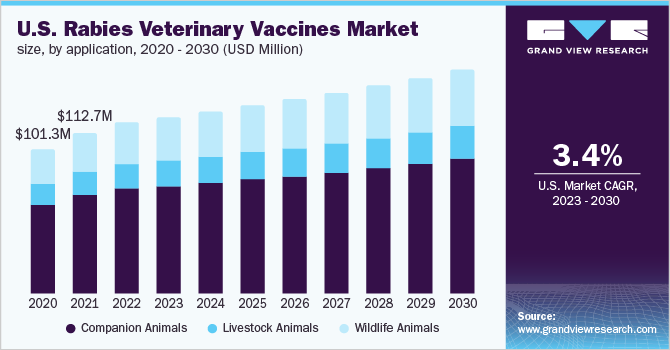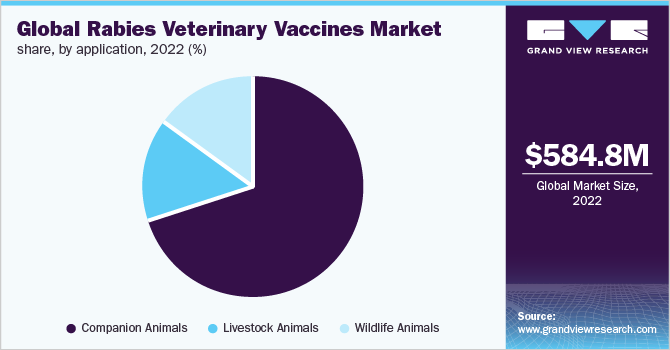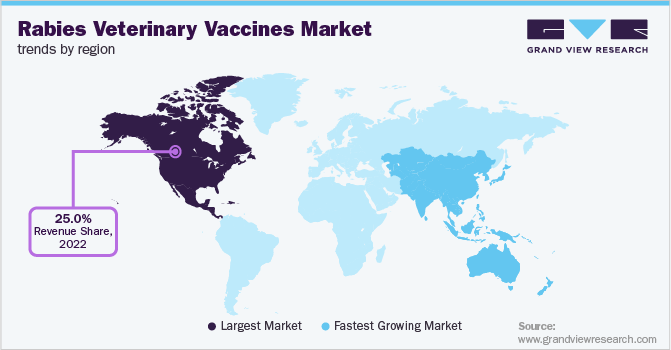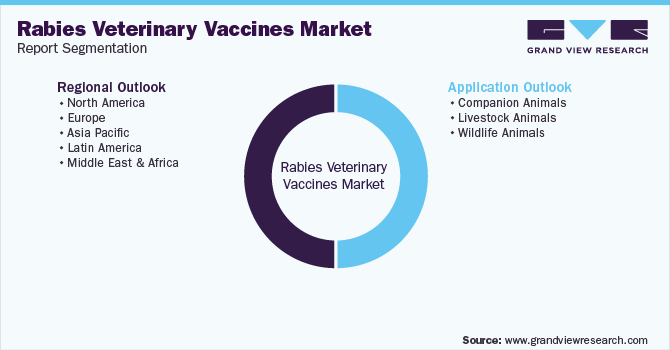- Home
- »
- Animal Health
- »
-
Rabies Veterinary Vaccines Market Size & Share Report, 2030GVR Report cover
![Rabies Veterinary Vaccines Market Size, Share & Trends Report]()
Rabies Veterinary Vaccines Market Size, Share & Trends Analysis Report By Application (Companion Animals, Livestock Animals, Wildlife Animals), By Region, And Segment Forecasts, 2023 - 2030
- Report ID: GVR-4-68040-011-9
- Number of Report Pages: 150
- Format: PDF, Horizon Databook
- Historical Range: 2018 - 2021
- Forecast Period: 2023 - 2030
- Industry: Healthcare
Report Overview
The global rabies veterinary vaccines market size was valued at USD 584.8 million in 2022 and is expected to expand at a compound annual growth rate (CAGR) of 4.1% from 2023 to 2030. The market growth is propelled by factors such as the rise in animal rabies vaccination coverage in developing countries, an increase in awareness regarding zoonotic diseases, growing government initiatives to eradicate animal rabies, nationwide and countrywide implementation of mass dog vaccination campaigns, rising wildlife rabies-eradication bait programs, and significant growth of pet ownership rates.

The most common way of this viral transmission is by the bite of a rabid animal to other domestic animals or humans. Rabies is a dangerous but preventable viral disease; however, in most cases without timely preventive or treatment measures, rabies virus affects animals' central nervous systems, ultimately leading to brain inflammation and death. According to a National Foundation for Infectious Diseases article, nearly 5,000 rabies cases in animals are reported in the U.S. each year, with over 90% of the cases occurring in wildlife, whereas domestic animals such as dogs and cats account for approximately 10% of animal rabies incidents.
Rabies is a dangerous and frequently fatal infection in any species. In developed countries such as the U.S. and Canada, the majority of rabies cases transmitted to humans, pets, and other domestic species are caused by rabid wild animals, including raccoons, skunks, foxes, and bats. In such countries, rabies has also been observed to infect horses, swine, and cattle. On the other hand, throughout a large portion of the rest of the world, including Africa, Asia, and Latin America, most cases of rabies transmission are caused by dogs. The fight to eradicate canine rabies in Latin America has made great advances in recent years. Constant and intense surveillance of rabid dogs and yearly mass dog vaccination campaigns have been key components of Latin America's rabies prevention programs, which lead to successful results. However, such rabies eradication and prevention initiatives have been threatened as a result of crucial attempts to control COVID-19 in several regions.
The provision of rabies vaccinations to domesticated animals such as dogs, cats, and ferrets is strictly regulated in the majority of countries. Only licensed veterinarians are permitted to give the vaccine, although some regions also let veterinary technicians and people with specialized training immunize these animals. State-by-state variations exist in the frequency of rabies vaccine requirements. Some states specify a time period, while others adhere to the Compendium of Animal Rabies Prevention and Control or the product label of the utilized vaccination. Additionally, some countries are starting to grant exceptions to vaccination laws, in cases when they are medically required by a veterinarian.
The European Union's methodical approach to combating canine and wildlife-mediated rabies has demonstrated that the illness can be controlled and eliminated at the animal source. The successful oral rabies vaccination campaign for foxes and raccoon dogs, which was the result of ten years of development effort and support by the European Union, served as a model for the eradication of wildlife-mediated rabies. Over the past few years or decades, rabies was eradicated in many European nations, including almost all EU Member States, EFTA nations, the U.K., Balkan nations, and some parts of Eastern European nations. Such an improvement was made possible by the effective multiannual implementation of the vaccination of dogs and cats, oral rabies immunization of wild animals, intense passive surveillance, and coordination with stakeholders in a ‘One Health’ strategy.
Application Insights
The companion animals segment dominated the global market with a revenue share of over 65.0% in 2022. Nearly 98% of rabies transmission in several parts of the world is caused by the infected dog population. The rabies virus can incubate in any mammal for days to months without definitive clinical signs, therefore limiting the timely treatments. This devastating viral infection causes severe inflammation in the brain leading usually to death. The only way of protecting pet animals and owners is by getting a regular rabies vaccination and boosters. Considering the major impact of this zoonotic neuroinvasive infection, many countries have mandated rabies vaccination for companion animals, which supports the estimated revenue share.
The wild animals segment is anticipated to expand at the fastest CAGR of 4.4% over the forecast period owing to the rising wildlife rabies vaccination campaigns in developed regions. According to the Centers for Disease Control & Prevention, wild animals were responsible for 92.7% of U.S. rabies cases registered in 2018. Raccoons (30.3%), skunks (20.3%), foxes (7.2%), and bats (33%) were the most commonly reported wild rabid species. Variants of the rabies virus remain spread within the species to which they have been widely adopted. Similarly, raccoons, foxes, skunks, and mongooses have rabies virus variations that are concentrated in specific geographical areas.

For instance, in every state of the U.S. besides Hawaii, rabid bats were reported between 2013 and 2022. In some areas of California, Texas, the Midwest, Virginia, North Carolina, Kentucky, and Tennessee, rabies-carrying skunks have been commonly identified. The South and Eastern states have reported finding rabid raccoons. There have been cases of rabid foxes in Alaska, Arizona, and New Mexico. Moreover, in Texas, Arizona, and New Mexico, rabies-carrying foxes and skunks have been found; whereas, in Puerto Rico, rabies-carrying mongooses have been seen.
According to an article published by the Centers for Disease Control and Prevention, domestic dogs no longer serve as a rabies reservoir in the United States due to the implementation of mandated canine vaccination programs that have stopped the disease's natural transmission among them. Nevertheless, each year, reports of rabid animals range from 60 to 70 canines to over 250 cats. Almost all of these animals lacked vaccinations and contracted rabies from wild animals (such as bats, raccoons, and skunks).
Regional Insights
North America dominated the market with a revenue share of over 25.0% in 2022. This can be attributed to the presence of a large pet population with respectively high veterinary healthcare expenditure. In addition, well-established veterinary pharmaceutical companies and government organizations are striving for the wide implementation of mass vaccination programs and oral wildlife rabies bait-vaccine campaigns to augment rabies eradication measures. The increasing pet humanization trends and awareness among pet owners to prevent fatal infections such as rabies in their beloved animals are further improving the vaccination coverage of the region.

Asia Pacific held the second-largest share in 2022 and is anticipated to grow at the fastest rate during the forecast period. Rabies is one of the major public health concerns in Southeast Asian countries. China, India, and most ASEAN countries are reported to be endemic for canine rabies with significantly higher rabies-related cases each year. The large presence of the stray dog population is a major reason for the disease burden in Asia. Recently, the region has initiated several strategies to eradicate rabies by 2030, such as the implementation of mass dog vaccination programs in collaboration with key players and government organizations. For instance, as a part of the rabies control initiative, Global Alliance for Rabies Control (GARC) and Boehringer Ingelheim have organized a mass rabies vaccination program in April 2022 to vaccinate 12,000 animals across the Philippines, Indonesia, Vietnam, and Malaysia. These factors are significantly contributing to the market growth.
Key Companies & Market Share Insights
The market is fairly competitive with the presence of several large and small players. Large companies are publicly traded and have diverse portfolios with robust R&D, distribution, and sales capabilities. Medium and small companies focus on specific solutions that cater to customer needs in the market. These include partnerships, mergers and acquisitions, R&D, regional expansion, and product launches. For instance, in June 2022, Ceva Sante Animale acquired Artemis Technologies, Inc., a Canadian oral rabies vaccine manufacturer. This acquisition expanded the company’s veterinary vaccine offerings with ONRAB, a recombinant oral vaccine that showed positive trial results for wild skunks and raccoons in the U.S. Some prominent players in the global rabies veterinary vaccines market include:
-
Merck & Co., Inc. (MSD Animal Health)
-
Indian Immunologicals Ltd.
-
Boehringer Ingelheim International GmbH (Animal Health)
-
Zoetis
-
Virbac
-
BroadChem Philippines Biopharma Corporation
-
Elanco
-
Ceva
-
BiogénesisBagó
Rabies Veterinary Vaccines Market Report Scope
Report Attribute
Details
Market size value in 2023
USD 605.9 million
Revenue forecast in 2030
USD 802.5 million
Growth rate
CAGR of 4.1% from 2023 to 2030
Base year for estimation
2022
Historical data
2018 - 2021
Forecast period
2023 - 2030
Quantitative units
Revenue in USD million & CAGR from 2023 to 2030
Report coverage
Revenue forecast, company share, competitive landscape, growth factors, and trends
Segments covered
Application, region
Regional Scope
North America; Europe; Asia Pacific; Latin America; Middle East & Africa
Country Scope
U.S.; Canada; Poland; Russia; Romania; Turkey; Spain; Japan; China; India; Thailand; South Korea; Brazil; Mexico; Argentina; South Africa; Saudi Arabia; UAE
Key companies profiled
Merck & Co., Inc. (MSD Animal Health); Indian Immunologicals Ltd.; Boehringer Ingelheim International GmbH (Animal Health); Zoetis; Virbac; BroadChem Philippines Biopharma Corporation; Elanco, Ceva, BiogénesisBagó
Customization scope
Free report customization (equivalent up to 8 analysts’ working days) with purchase. Addition or alteration to country, regional & segment scope.
Pricing and purchase options
Avail customized purchase options to meet your exact research needs. Explore purchase options
Global Rabies Veterinary Vaccines Market Segmentation
This report forecasts revenue growth at the global, regional, and country levels and provides an analysis of the latest industry trends and opportunities in each of the sub-segments from 2018 to 2030. For the purpose of this study, Grand View Research has segmented the global rabies veterinary vaccines market report on the basis of application and region:

-
Application Outlook (Revenue, USD Million, 2018 - 2030)
-
Companion Animals
-
Livestock Animals
-
Wildlife Animals
-
-
Regional Outlook (Revenue, USD Million, 2018 - 2030)
-
North America
-
U.S.
-
Canada
-
-
Europe
-
Poland
-
Russia
-
Romania
-
Turkey
-
Spain
-
-
Asia Pacific
-
China
-
Japan
-
India
-
South Korea
-
Thailand
-
-
Latin America
-
Brazil
-
Mexico
-
Argentina
-
-
Middle East & Africa
-
South Africa
-
South Arabia
-
UAE
-
-
Frequently Asked Questions About This Report
b. The global rabies veterinary vaccines market size was estimated at USD 584.8 million in 2022 and is expected to reach USD 605.9 million in 2023.
b. The global rabies veterinary vaccines market is expected to grow at a compound annual growth rate (CAGR) of 4.1% from 2023 to 2030 to reach USD 802.5 million by 2030.
b. North America dominated the global rabies veterinary vaccines market with a share of over 25% in 2022. This is attributable to the large pet population coupled with mandatory rabies vaccine measures.
b. Some key players operating in the global rabies veterinary vaccines market include Merck & Co., Inc. (MSD Animal Health); Indian Immunologicals Ltd; Boehringer Ingelheim International GmbH (Animal Health); Zoetis; Virbac; BroadChem Philippines Biopharma Corporation; Elanco, Ceva, and Biogénesis Bagó.
b. Key factors that are driving the market growth include the increasing rabies vaccination coverage for dogs, rising zoonosis concerns, growing government initiatives to eradicate rabies, and increasing dog ownership rates.
Share this report with your colleague or friend.
![gvr icn]()
NEED A CUSTOM REPORT?
We can customize every report - free of charge - including purchasing stand-alone sections or country-level reports, as well as offer affordable discounts for start-ups & universities. Contact us now
![Certified Icon]()
We are GDPR and CCPA compliant! Your transaction & personal information is safe and secure. For more details, please read our privacy policy.
We are committed towards customer satisfaction, and quality service.
"The quality of research they have done for us has been excellent."





